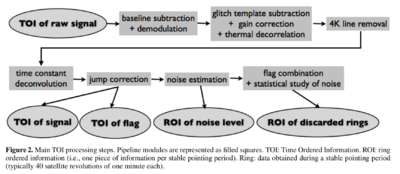HFI performance summary
The HFI operated flawlessly for 30 months, the maximum autonomy expected for the helium of the dilution cooler. The telescope pointing was achieved with an accuracy better than expected and reconstructed to a few seconds of arc. Fifty of the 52 bolometers collected data in very stable conditions during the whole mission, and practically all of the data were correctly recorded.
The extreme sensitivity provided by the 100 mK bolometers and the HFI architecture provided a new view of the submillimetre and millimetre sky, with a noise level not far from the fundamental limits set by the photon noise of the observed source. However, expected and unexpected systematic effects were seen, the most noticeable of them being the spikes in the signal produced by cosmic rays hitting the bolometers and their immediate surroundings.
The noise performance of the HFI bolometers is measured on timelines which have been cleaned of features such as glitches, and from which the signal has been removed. The cleaning process has evolved overtime and the measured noise characteristics have correspondingly changed. The diagram below (from Planck-Early-V[1] illustrates the main steps of the cleaning process.
The figures below show examples (from Planck-Early-V[1]) of the cleaning and signal removal process.
[[File:
The two tables below give two snapshots of the evolution of the noise estimation. The first table (from Planck-2013-XII[2]) applies to the 2013 release products, and the second table (from Planck-2015-A06[3]) applies to the 2015 and 2018 release products.
The overall sensitivity for the 2013 release was around that announced as the goal in the "bluebook" [4] , i.e. 2 times better than the required sensitivity. These numbers improved by about √2 when the whole mission data become available.
After basic processing and cleaning, the bolometer noise power spectra still contain non-white components, as can be seen in the following spectra (from Planck-2015-A06[3]).
The noise characteristics also vary slightly during the mission, as can be seen in the following diagrams (from Planck-2015-A06[3]; note that the horizontal axis labels are left-right transposed).
A four component noise model is fitted to the data, as exemplified in the figure below (from Planck-2020-A3[5]).
The most recent analysis of detector noise characteristics can be found in Planck-2016-XLVI[6]; an example spectrum is in the figure below.
Average characteristics of the HFI can also be estimated at map level. The table below gathers parameters based on the 2013 release. The sensitivity here is obtained from the half difference of the half rings.
| Frequency | 100 GHz | 143 GHz | 217 GHz | 353 GHz | 545 GHz | 857 GHz |
| Beam size [FWHM, arcmin] | 9.66 | 7.27 | 5.01 | 4.86 | 4.84 | 4.63 |
| Sensitivity per fiducial pixel | 3.95 µK/K | 2.35 µK/K | 4.58 µK/K | 15.17 µK/K | 0.013 MJy sr-1 (*) | 0.013 MJy sr-1 (*) |
| Goal sensitivity | 2.5 µK/K | 2.2 µK/K | 4.8 µK/K | 14.7 µK/K | 0.023 MJy sr-1 | 0.041 MJy sr-1 |
(*) These sensitivities are only valid for high Galactic latitude.
During map-making, subtle systematic effects can be corrected to a much higher degree than at timeline level. This process is described in detail for the 2015 products in Planck-2015-A07[7] and for the 2018 products in Planck-2020-A3[5]. Those papers contain full assessments of the remaining levels of systematic effects.
references[edit]
- ↑ Jump up to: 1.01.1 Planck early results. V. The Low Frequency Instrument data processing, A. Zacchei, D. Maino, C. Baccigalupi, et al. , A&A, 536, A5, (2011).
- Jump up ↑ Planck 2013 results. XI. Component separation, Planck Collaboration, 2014, A&A, 571, A11.
- ↑ Jump up to: 3.03.13.2 Planck 2015 results. VI. LFI mapmaking, Planck Collaboration, 2016, A&A, 594, A6.
- Jump up ↑ The Scientific Programme of Planck, Planck Collaboration, ESA publication ESA-SCI(2005)/01, (2005).
- ↑ Jump up to: 5.05.1 Planck 2018 results. III. High Frequency Instrument data processing and frequency maps, Planck Collaboration, 2020, A&A, 641, A3.
- Jump up ↑ Planck intermediate results. XLVI. Reduction of large-scale systematic effects in HFI polarization maps and estimation of the reionization optical depth, Planck Collaboration Int. XLVI A&A, 596, A107, (2016).
- Jump up ↑ Planck 2015 results. VII. High Frequency Instrument data processing: Time-ordered information and beam processing, Planck Collaboration, 2016, A&A, 594, A7.
(Planck) High Frequency Instrument
Full-Width-at-Half-Maximum
European Space Agency









